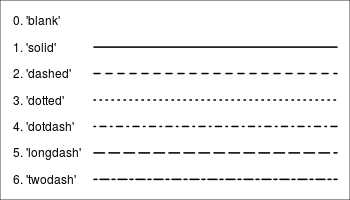Shapes and line types for R
来源:互联网 发布:淘宝火牛软件 编辑:程序博客网 时间:2024/05/17 01:50


Note that with bitmap output, the filled symbols 15-18 may render without proper anti-aliasing; they can appear jagged, pixelated, and not properly centered, though this varies among platforms. Symbols 19 and 21-25 have an outline around the filled area, and will render with smoothed edges on most platforms. For symbols 21-25 to appear solid, you will also need to specify a fill (bg) color that is the same as the outline color (col); otherwise they will be hollow.
Standard graphics
Use the
pch
option to set the shape, and use
lty
and
lwd
to set the line type and width. The line type can be specified by name or by number.
set.seed(331)# Plot some points with lines# Set up the plotting areapar(mar=c(3,3,2,2))plot(NA, xlim=c(1,4), ylim=c(0,1))# Plot solid circles with solid linespoints(1:4, runif(4), type="b", pch=19)# Add open squares with dashed line, with heavier line widthpoints(1:4, runif(4), type="b", pch=0, lty=2, lwd=3)points(1:4, runif(4), type="b", pch=23, # Diamond shape lty="dotted", cex=2, # Dotted line, double-size shapes col="#000099", bg="#FF6666") # blue line, red fill

ggplot2
With ggplot2, shapes and line types can be assigned overall (e.g., if you want all points to be squares, or all lines to be dashed), or they can be conditioned on a variable.
# Sample datadf <- read.table(header=T, text=' cond xval yval A 1 2.0 A 2 2.5 B 1 3.0 B 2 2.0')library(ggplot2)# Plot with standard lines and points# group = cond tells it which points to connect with linesggplot(df, aes(x=xval, y=yval, group = cond)) + geom_line() + geom_point()# Set overall shapes and line typeggplot(df, aes(x=xval, y=yval, group = cond)) + geom_line(linetype="dashed", # Dashed line size = 1.5) + # Thicker line geom_point(shape = 0, # Hollow squares size = 4) # Large points# Condition shapes and line type on variable condggplot(df, aes(x=xval, y=yval, group = cond)) + geom_line(aes(linetype=cond), # Line type depends on cond size = 1.5) + # Thicker line geom_point(aes(shape=cond), # Shape depends on cond size = 4) # Large points# Same as previous, but also change the specific linetypes and# shapes that are usedggplot(df, aes(x=xval, y=yval, group = cond)) + geom_line(aes(linetype=cond), # Line type depends on cond size = 1.5) + # Thicker line geom_point(aes(shape=cond), # Shape depends on cond size = 4) + # Large points scale_shape_manual(values=c(6,5)) + # Change shapes scale_linetype_manual(values=c("dotdash", "dotted")) # Change linetypes




By default, ggplot2 uses solid shapes. If you want to use hollow shapes, without manually declaring each shape, you can use
scale_shape(solid=FALSE)
. Note, however, that the lines will visible inside the shape. To avoid this, you can use shapes 21-25 and specify a white fill.
# Hollow shapesggplot(df, aes(x=xval, y=yval, group = cond)) + geom_line(aes(linetype=cond), # Line type depends on cond size = 1.5) + # Thicker line geom_point(aes(shape=cond), # Shape depends on cond size = 4) + # Large points scale_shape(solid=FALSE)# Shapes with white fillggplot(df, aes(x=xval, y=yval, group = cond)) + geom_line(aes(linetype=cond), # Line type depends on cond size = 1.5) + # Thicker line geom_point(aes(shape=cond), # Shape depends on cond fill = "white", # White fill size = 4) + # Large points scale_shape_manual(values=c(21,24)) # Shapes: Filled circle, triangle


Note
This code will generate the chart of line types seen at the top.
par(mar=c(0,0,0,0))# Set up the plotting areaplot(NA, xlim=c(0,1), ylim=c(6.5, -0.5), xaxt="n", yaxt="n", xlab=NA, ylab=NA )# Draw the linesfor (i in 0:6) { points(c(0.25,1), c(i,i), lty=i, lwd=2, type="l")}# Add labelstext(0, 0, "0. 'blank'" , adj=c(0,.5))text(0, 1, "1. 'solid'" , adj=c(0,.5))text(0, 2, "2. 'dashed'" , adj=c(0,.5))text(0, 3, "3. 'dotted'" , adj=c(0,.5))text(0, 4, "4. 'dotdash'" , adj=c(0,.5))text(0, 5, "5. 'longdash'", adj=c(0,.5))text(0, 6, "6. 'twodash'" , adj=c(0,.5))
- Shapes and line types for R
- Notes on tensorflow(五)Tensor Ranks, Shapes, and Types
- custom textures and Shapes
- Coordinate System and Shapes
- tensorflow Shapes and Shaping
- distinct between point and line (for svm)
- tensorflow: Shapes and Shaping 探究
- 第九章 Helper functions and types for Libevent
- [R and Matlab] Add or delete multi-line comments
- Gnuplot线和点的种类(Line and Point Types)
- Gnuplot使用技巧:线和点的种类(Line and Point Types)
- Use the Shapes window to organize and find shapes
- Reference Types and Values Types
- Generic types and Wildcard types
- R Packages for GWAS and GS
- Primitive Types and Objects
- TCPL_4 types and declarations
- Types and Number Representation
- R语言 判别分析
- python初级教程:入门详解:网址
- 下载和安装R、RStudio !~~~
- SNA社交网络R语言分析
- Eclipse Git开发流程
- Shapes and line types for R
- Windows 7 64位系统下安装Cy+NS2经验(成功安装)
- java--Socket编程
- igraph软件包创建图和网络(创建邻接矩阵)
- R包—iGraph
- [学习分享] R软件用于社会网络分析——探索人人网好友推荐系统
- Hive Order By操作
- Hive一个表创建另一个表,表分区
- git添加远程仓库,提交代码,更新代码


